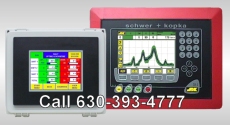 Monitoring Products, Sensors, and Data Collection Software for all Production Environments. |

|
|
|
IMPAX Monitor FeaturesMany software features are available in IMPAX process monitors. You can learn more about the various features below. Process monitoring features:Peak/Area Under Curve Monitoring: The basic monitoring types for IMPAX monitors. "Peak" refers to the maximum sensor input signal seen during the manufacturing process, while "Area Under Curve" refers to the integration (sum over time) of the force curve. By tracking both, IMPAX units "learn" a given machine cycle's profile. Programmable Tolerances: Control limits for the process, determined in two ways: "Calculated" limits are determined by the IMPAX unit's tolerance feature, and are allowed to adjust slightly over time to account for "non-critical" force changes (tool warm-up, material changes, drift, etc.). "Fixed" limits are control limits that are manually entered during setup and never allowed to change. Fixed limits are entered independently and are not controlled by any other tolerance setting. Crash Limits: Strict limits that are always in place to prevent crashes and smash-ups. Immediate Limits: The ability of the unit to store the previous control limits and compare any subsequent start-up (forces) to those limits. This feature eliminates the need for the IMPAX unit to relearn the force settings after each shutdown. Trending Limits: An absolute limit that enables a channel's forces to drift up or down within a predetermined percentage-based window. Limits Averaging: The ability to statistically average force values over three levels of magnitude. Speed Monitoring: Instantly stops the machinery when unwanted speed changes occur. Can also give a warning prior to stop. Short-Feed Monitoring: Utilizes a sensor that mounts to the machine's feed stop arm and monitors for a short-feed condition. Data tracking features:Production Counter: Allows the user to predetermine a desired production count and automatically stop the machine when this count is reached. The production counter displays the current production level in both a count-up and count-down mode. Maintenance Counter: Allows the user to predetermine a desired maintenance count for tool changes, SPC inspections, machine adjustments, etc. and automatically stop the machine or take other action when this count is reached. The maintenance counter displays the current production level in both a count-up and count-down mode. Shift Counter: A counter that operates in a count-up mode only and may be reset at any time to track shift or other production. RPM Indicator: An accurate indication of true machine speed for setup to setup consistency. Reminds the operator if the machine is running either too slow or too fast when compared to the recommended or specified job speed. Production Timer: A portion of the real-time clock that monitors the time in each mode of operations. This timer will ultimately assist in calculating machine efficiency and uptime. Keeps track of actual production time, set-up time, downtime, and the time the machine is powered down. Error Events Log: Historical buffer of the previous eight sets of error conditions. Each error message set includes; the locations of the error, the time and date the error occurred, the magnitude of error, a display of the control limits at the time of the error, and tolerance setting & variation. Downtime Analyzer: An analysis feature (within the software) that enables the IMPAX to monitor up to 99 independent downtime code entries. Up to eight downtime codes can be entered for each downtime occurrence. Shop Floor Data Entry: Enables the operator to utilizes the IMPAX keypad to log specific time stamped alphanumeric shop floor data such as coil number, heat number, tool number, lot number, operator number, etc. Up to sixteen discreet tags are available for use. May also be used to log the operator on or off work. Other features:Mode Indication Status: A visual indication of whether the machine is running, and whether the IMPAX has learned the process and is protecting it. Supervisor Lock-out Option: A key-lock feature that prevents unauthorized programming of the IMPAX unit. Real-Time Clock: The battery backed-up portion of the processor that monitors time and time and date stamps each mode change in the system. Alphanumeric Display: Full alphabetic and numeric display capability. Alphanumeric Entry: Enables the operator to input either numeric and alpha characters. Defective Sensor Diagnostics: Tool that alerts the operarator if a sensor is faulty. Input/Output:Sensor Inputs: The analog inputs dedicated to reading process force, by reading the signals from one or more process sensors. Timing Inputs: The digital (on/off) inputs dedicated to reading timing information, such as when in the cycle the machine is doing work. Relay Outputs: The relays available to shut the machine down if a problem or crash is detected, or perform other tasks such as stop feeds, disable a conveyor, etc. |